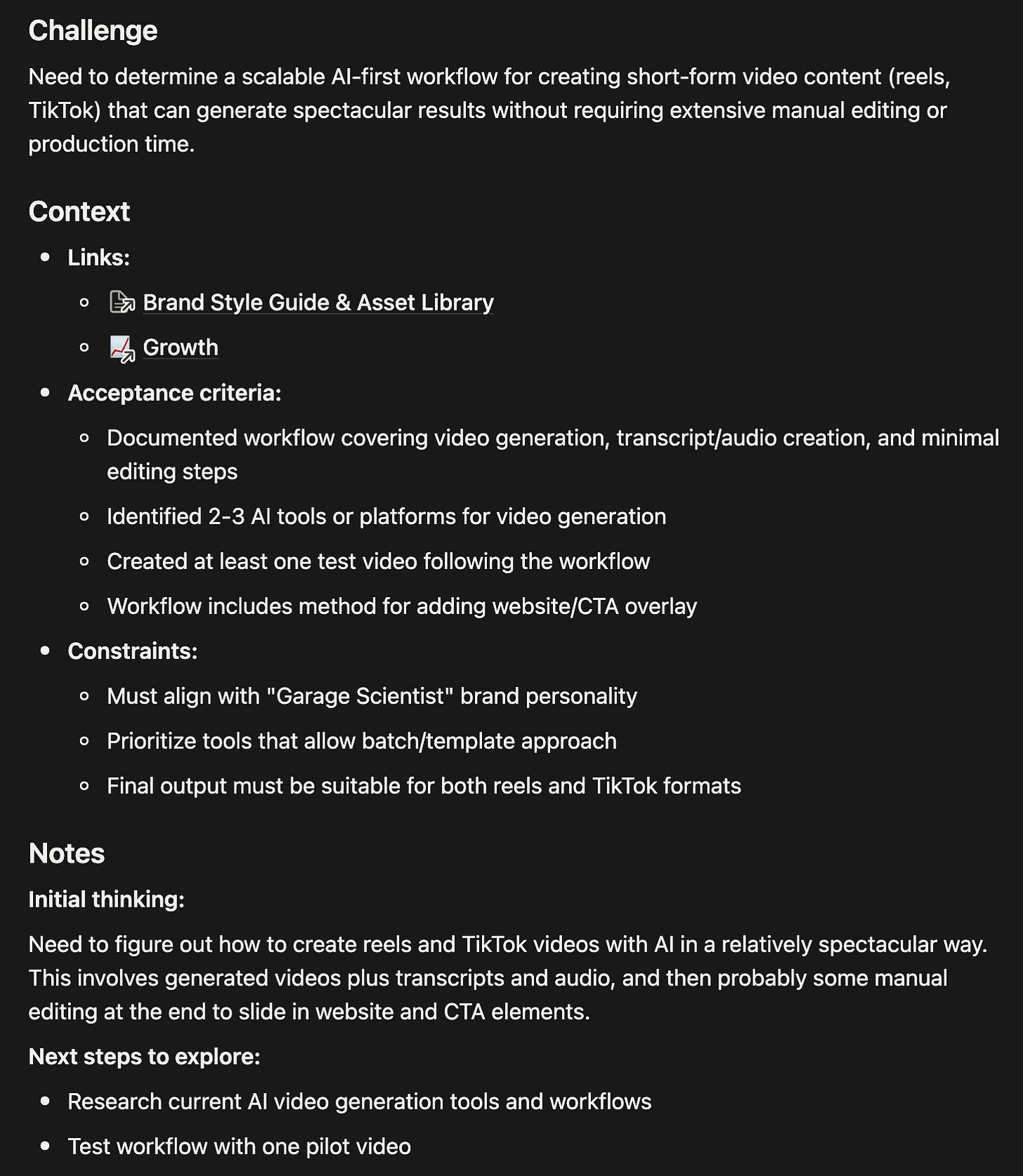How my $30/mo Notion AI agent does my work for me
Working has never felt so different.
Obviously, we’re all looking for ways to be more productive with AI.
I thought I had it down.
I built a few AI automations that were getting me great results and even made some regrettable comments on social media on how much more useful specific automations were compared to agents.
I feel silly about how little I actually knew.
It turns out that a good AI agent, one that understands your goals, your principles, your processes, and your work, is way more useful than I’ve admitted in the past.
So here, I’ll show you how I’ve set up my Notion workspace over the past 2 months to get the most out of Notions AI.
It crushes dynamic work. Meaning work I don’t have a process for yet. And it does that by knowing by business well enough to do work even better than I can prompt it to do.
All for $30/mo
Why I switched to Notion AI
I was using ChatGPT for the most part, otherwise scraping together pieces from different tools to get work done.
CustomGPTs, projects with specific context, saved prompts I can copy over etc..
Then, randomly, I saw someone’s tweet saying how much better Notion AI is now. It was something I had completely forgotten about despite using Notion every single day. Now I’m an advocate.
If you’ve ever used Cursor to vibe code, Notion AI reminds me a lot of that. You have all these folders and files, and the AI module on the left of the screen searches through all your connected assets to find relevant context anytime you give it a prompt.
I immediately saw the value and established 2 goals for what I wanted Notion AI to be able to accomplish for me:
It should be able to complete any part of a task that doesn’t require a deliverable outside of Notion (to at least 80% completion).
It should be able to complete all my sales admin: Update my CRM based on conversation history, create next steps for deals and put them in my tasks db, and write proposals all based on playbooks I’ve agreed upon.
Today, it does all this. Sure, there’s room for improvement. And these workflows are still in development as well. But I’m incredibly impressed.
I’ll have more specific examples of what kind of tasks Notion AI completes for me later on.
To reach these goals, I focused on Context Engineering.
Context engineering explained
Here is a ChatGPT provided definition of context engineering:
Context engineering is the discipline of designing, shaping, and controlling the context in which an AI system—especially a large language model (LLM)—operates, so it consistently produces useful, accurate, and aligned outputs.
Think of it as the next step beyond prompt engineering — instead of writing a single clever prompt, you engineer the entire environment (data, memory, constraints, tools, goals, and feedback loops) that the AI reasons within.
This is the AI version of having business documentation and standard operating procedures in place.
No more creating projects and uploading pdfs in ChatGPT.
No more engineering long structured prompts.
Often, I enter a one sentence (sometime misspelled) prompt, and an hour of work just disappears.
The AI agent knows, for example, that I always want to start with the smallest iteration of a project and test it. Thus, it always proves its work reflects that core principle.
It knows that I want everything documented, so when I ask it to complete at task, it first creates a task, uses a documented task creation SOP to fill it out, completes the task, then moves the task to “Done”.
It knows that it is taking part in the context engineering process, so when the completion of a project justifies new documentation, it creates the documents, and puts them in the right area.
The more I work with it, the better it’s own performance.
My Notion structure
I have five basic areas: Home, Strategy, Growth, Product, and Ops. In the marketing related stuff, it’s going to look through the Growth section. For tasks and organizational items, it looks through ops. Strategy is my North Star area that keeps us aligned on direction and goals.
Every area is structured the same way:
Overview and strategic things it should know
Playbooks and SOPs
Quick links to assets and databases
This repetition is intentional. In every area, the AI knows what’s a guiding policy versus what’s a specific step by step path.
It’s very simple, and very effective.
Here is a look in my Ops space:
The Constitution
The most important asset is the Constitution. This is set as the system prompt, so it reads this every single time I give it a query.
The constitution includes:
Our mission & vision
Principles (how we work)
Operating System
Roles - what I do vs what the AI does
Important business metrics
Notion Workspace Schema
Change log - if we change the constitution, what we changed.
I don’t know if it’s perfect, but it works well and keeps the agent focused on how I want all work done.
Note: the first sentence is an instruction to not change anything in my workspace without explicit approval. I highly recommend included this so the agent doesn’t move around in wrecking ball fashion.
Task SOP - my most useful piece of context
To give an example of an incredibly useful piece of context, I use my Task SOP multiple times a day.
It’s a simple document.
It outlines how I want all of my tasks laid out.
How the title should be phrased
Establish the core goal/challenge first thing
Provide all the context related to the task (communications with other parties, related documents in my workspace, clients, meetings, seriously anything related)
A definition of done - so the deliverable is clear
Then a section labeled notes, that I drop information in while completing the task
This is an incredibly useful way to lay out all your tasks. It squashes any confusion, and gives anyone who looks at the task enough information to complete it with minimal additional questions.
The problem, of course, is I rarely ever fill out a task with this much rigor.
Notion’s AI agent has solved this problem in its entirety.
Now, when I create a task, I write a 3-4 sentence description of what I’m thinking for this task. Then, I tell the agent to fill out the task based on the Task SOP.
It takes my description, searches the rest of my workspace for context, and fills out the task near perfectly. Now, despite my lack of rigor on the small things, if you came into my workspace, you would know what’s being worked on and how to complete each task.
Here’s a recent example of a task to research video generation it filled out on my behalf:
You might be thinking to yourself, “But wait a second Adam. You’re a solo operator, a lone wolf, why do you need your tasks written out? Can’t you just remember them?”
Great question! You’re too smart for your own good.
You may or may not have noticed that a well written task is eerily similar to what a well written prompt looks like.
It’s not for me, it’s for the Agent.
The first step after checking its work on the task is the simple prompt “complete as much of this task as you can, and put the results in the notes.”
And boom! 80% of the task is done. Leaving me to make some small decisions and put it in whatever format I want the deliverable.
The meta part
A smart person, like you, would ask at this point, “Ok. but how long did it take you to set this all up?”
Here’s the thing: I did not create these assets. The AI created these assets. Strange world, I know.
I know what I’m going for in the structure and what I want on each of these documents. Then I just tell the AI to create the draft of this playbook or SOP. It knows what a playbook is because I created the constitution, which was also AI generated. Obviously I edit everything.
The AI created the context environment with my direction.
I’m just talking with the AI saying, hey, I want to create this kind of documentation because I think it’ll be good for the context you have available. This is my goal of this documentation. Here’s the things I think will be in it. And then, boom, I have a constitution, or a playbook, or a new database.
I had all of the versions of these documents up in a day or less.
Then, over the weeks, I’m telling the AI to change it.
One time, I had it create a task and the task title was very fluffy and vague.
I said, “hey, that task title sucks. I want you to forever create task titles in this format. Please go back and change the task SOP so that it reflects that.”
Making these changes to your context becomes super lightweight and easy because you get to just tell the AI to make the change. And now each time the output is improved because the AI is helping you develop the context that will improve and make it better.
Last trick - Whisper Flow
Last trick. I use WhisperFlow which lets me hold Fn to record my voice, then release to paste it wherever my cursor is. This makes the cycle really fast.
I think only half my typing is actual typing at this point.
The other half I’m just sitting here holding Fn, talking to my AI and watching it do a bunch of work.
I can rattle off a whole essay of my thoughts and it takes all that, changes my context, changes my workspace, or completes the task.
Conclusion
I can think of any set of tools that have actually changed the way I work more than the few I’ve mentioned in this article.
I’m not typically a tool junkie, so I’d be with you if you’re skeptical of that actual productivity add in this system. But I’ll keep you updated. Working well for me so far.





I really enjoyed reading this article. By the way, the tip for WisperFlow, I think I'm going give it a try.